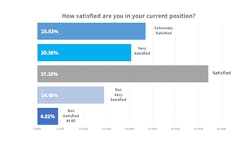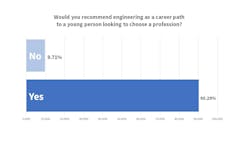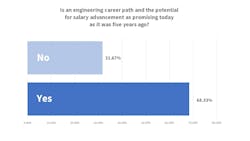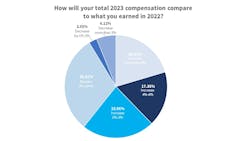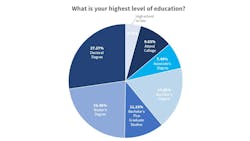Laser Focus World's 2023 career and salary survey results
Photonics professionals who are curious about what their peers think of their jobs and careers and those trying to retain or attract highly qualified engineers will find interesting results from the recent Laser Focus World survey. Conducted last fall, the results offer a peek into the work-life details of photonics research and engineering professionals, including salary, work satisfaction, and outlook for the future.
Overall job satisfaction among respondents is high, with 44% declaring they are extremely or very satisfied in their current position. Adding those who are satisfied pushes the result to 80%. These results track similarly to the 88.5% of respondents who remain in the same job held the previous year.
Despite high satisfaction and the tendency to stay in the same job, the results suggest many respondents remain open to pursuing other opportunities. Forty-four percent of those who changed positions within the last year left their company to pursue other opportunities, more than double the 20% who changed jobs due to a merit-based promotion with the same employer.
Additionally, 15.6% report they are actively seeking a new position, and nearly 30% say that, though they are not actively seeking a new job, they would follow up on an interesting opportunity if they read or hear about it. Still, a third of respondents say they cannot envision changing jobs in the foreseeable future.
Also, over 65% have never considered leaving the engineering profession. Of the 35% who have, most (47%) give the reason to “try something different.” Red flags for companies trying to retain engineers land in the second through fourth most often selected reasons. “To make more money” comes in at No. 2 with 46%, followed by “burnout” (42%) and “do something more fulfilling or satisfying” (40%). A significant percentage sought more freedom/free time (38%), something less stressful (37.1%), or a better chance for advancement (30%). The question encouraged respondents to choose all the reasons that applied.
It is unclear whether the restlessness among those who have considered leaving is caused more by long-tenured professionals seeking change or a bias toward curiosity and challenge-seeking. However, 58% of the respondents are 50-plus years old—with a full third aged 60 or over. Moreover, 16.1%—the largest group of respondents—have worked in engineering for 40 years or more, and 58.5% have worked in engineering for 20 years to over 40 years.
Other factors that respondents say influence their job satisfaction could shed some light on why respondents might consider leaving a job or the engineering profession. The top response by weighted average is “researching potential design solutions,” followed closely by "the compensation you receive for the work you do” and "your company’s culture and values.” Ranking fourth is "the challenges that accompany the design of new products.”
Advising future generations
Respondents’ advice for the next generation of engineers was overwhelmingly upbeat about the future of engineering, with 90.3% saying they would recommend engineering as a career path to a young person looking to choose a profession, and over 68% saying they believe an engineering career path’s potential for salary advancement is as promising today as it was five years ago.
Respondents who would recommend engineering as a career path highlighted the variety and stability of an engineering career and noted the jobs are “interesting, creative, and relatively highly regarded.”
“It’s still a fun and challenging career that can be suitable for a wide range of personality types and many different branching paths to explore,” commented one respondent. Another wrote: “Interesting work, opportunity for career advancement, trajectories to management or teaching.”
Still, others cautioned: “If you have tenacity and enjoy creating, you can succeed, but you must know what your goals are, and you have to be diligent.” Additionally, commenters cite the need for young people exploring engineering to demonstrate aptitude for the profession and to be committed to “upskilling continuously.”
Those optimistic about the potential for salary advancement over the coming five years cited increased opportunities due to continual technology advances and innovation boosting demand for trained and experienced engineering professionals. Several mentioned the trend toward using artificial intelligence, robotics, and automation. One remarked bluntly, “Engineering is always needed.” Others noted that demand for engineers outpaces supply while the current pool “is aging out.”
Mostly rising salaries
Perhaps optimism for engineering pay increases over five years is influenced by most respondents’ recent experiences. Over 60% said their total compensation, including salary, bonuses, etc., increased in 2023 compared to 2022, with about 20% of respondents reporting an increase of more than 6%, 17.4% indicating increases of 4% to 6%, and 23%, increases of 1% to 3%.
However, that leaves 30.6% who received no raise and just over 6% whose compensation decreased by more than 3%.
When asked whether respondents feel their company adequately compensates them, 60% responded “yes.” Of those feeling unfairly compensated, over 50% feel they would need a raise of between 11% and 25% to achieve a fair compensation level.
Budgeting and hiring
The status of hiring and budgeting at respondents’ companies was mixed during the survey deployment. Though over a quarter of the respondents (25.7%) reported hiring increases, 30.6% say hiring for new positions was on hold, 29.7% faced budget cuts to the engineering department or workforce reductions/layoffs, and nearly 5% have had furloughs. (Respondents to this question could choose all that apply.)
Nearly 65% of respondents believe their company is as focused on employee retention this year versus last year.
The engineering employment outlook for the coming year looks mostly positive. Thirty-eight percent say their company plans to increase the number of engineering jobs, while over half (52%) plan to maintain the current level, and only 10.3% plan to scale back.
Engineering shortage
However, those seeking to increase engineering jobs could run into headwinds. Nearly 69% of respondents believe there is an engineer shortage. And over 67% of respondents say their organization has difficulty finding qualified candidates for open engineering positions. Photonics (48.1%), systems engineering (40%), and software (31%) are the top three engineering specialties where qualified candidates are hard to find.
Despite the challenges of finding new engineering hires, over half (55.8%) say their company has never offered signing bonuses as incentives for new engineering hires. Just under 20% offer them, though 7.4% indicated their company recently added them, and another 3.6% recently reinstated the practice.
Demographics
The nearly all male (just under 90%) respondent pool hailed from companies large and small, with the largest cohorts either at companies that gross $10 billion or more annually (10.9%) or less than $1 million (14.7%). Likewise, the number of employees their companies employ ranged widely. Most respondents (31.2%) worked at companies with over 1,000 employees or 50 or fewer (34.4%).
Though responses came from a cross-section of the photonics community, design and development engineers comprised the largest group at 32%, followed by executive/operation management, with nearly 15%, and just over 9% from engineering management. When asked what best describes their current design project, over 16.8 said R&D, while 10.5% indicated industrial control systems and equipment (including robotics).
The respondent group is well-educated, with more than 60% of respondents having at least a bachelor’s degree plus graduate studies. Nearly 27.3% hold a doctoral degree, and 22.5% have a master’s degree.
About the Author
Patricia Panchak
Patricia Panchak has held editorial leadership roles for over 25 years—15 years of which were with IndustryWeek as the brand’s managing editor and then editor-in-chief. From 2011 through 2017, she then served as group content director for the Manufacturing & Supply Chain Group, which included IndustryWeek.
Since 2018, Patricia spent time as a business journalist, editorial consultant, and public speaker, specializing in business and manufacturing strategies and best practices; trends and emerging technologies; and public policy.

